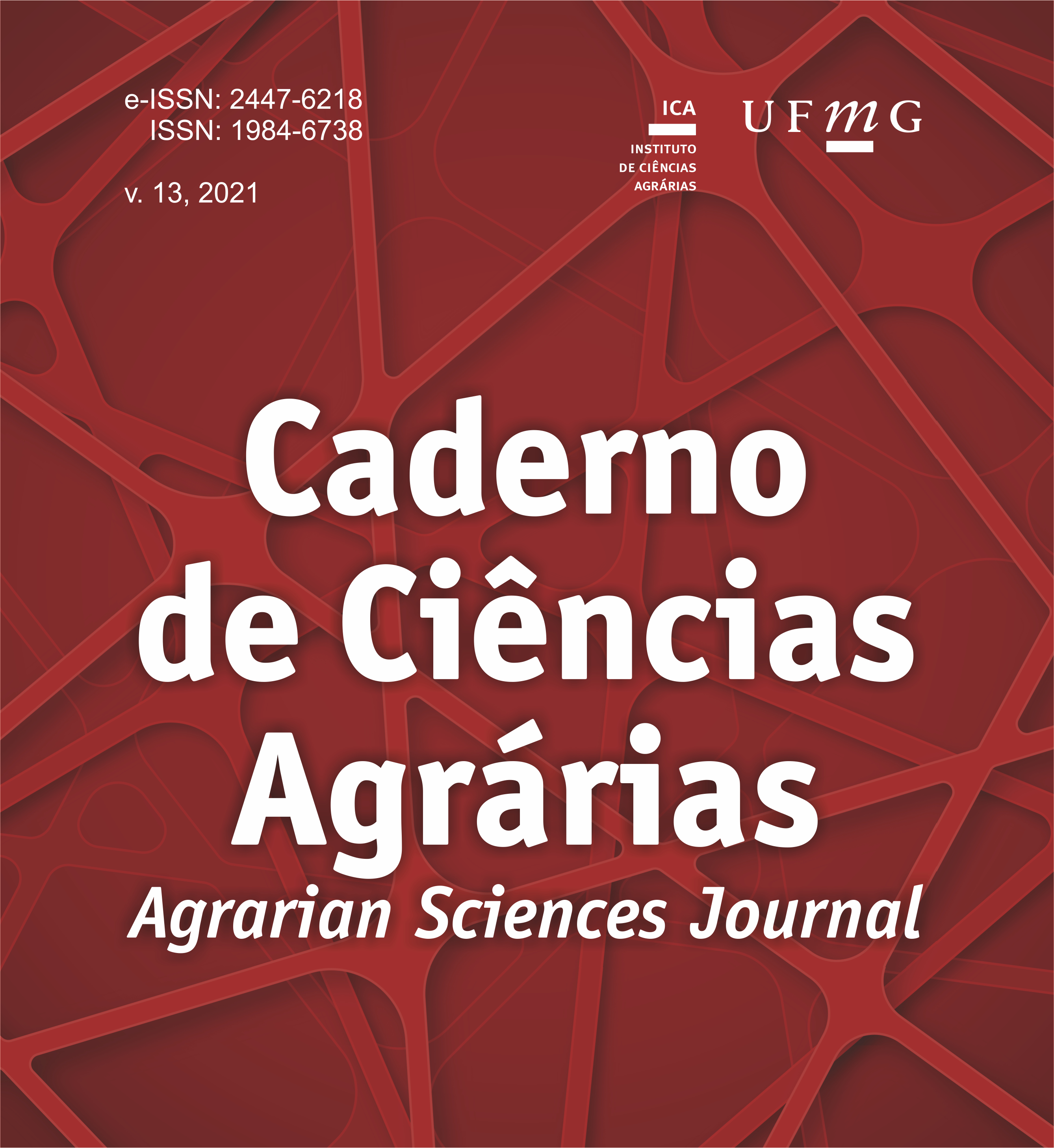In vitro evaluation of the probiotic potential of microorganisms isolated from functional commercial fermented milks
DOI:
https://doi.org/10.35699/2447-6218.2021.35380Keywords:
Antagonism, Lactobacillus, Resistance to gastrointestinal transitAbstract
Fermented milk is one of the carriers of probiotics, which is a Greek derived term meaning "pro-life". Probiotics are live microorganisms that, when administered in adequate and daily amounts, confer benefits to host’s health. In this work, four in vitro tests were performed with six lactobacilli samples from commercial fermented milks: sensitivity test to gastric pH, sensitivity test to intestinal bile salts, antagonism test against pathogens and susceptibility test to antimicrobials. The tested samples were resistant to gastric pH (2.0) and some suffered growth inhibition in the sensitivity tests to bile salts (0.3%), in two different methods, reducing growth in about 45% or 1 Log10 reduction. All pathogenic bacteria tested (Escherichia coli, Salmonella enterica serovar Typhimurium and Staphylococcus aureus) were antagonized by the supernatant (in MRS) of Lactobacillus spp. isolated from commercial fermented milks as well as in spot on the lawn test. Regarding antimicrobial susceptibility, samples presented a diverse profile, with prevalence of sensitivity to antimicrobials of clinical relevance, although there was high resistance profile regarding cephalosporins. In view of the in vitro tests performed, samples showed a satisfactory probiotic potential, as expected. However, some samples showed a slightly superior performance, such as Lactobacillus casei Shirota from Yakult, L. casei Defensis from Actimel and L. paracasei ST11 from Chamyto.
Downloads
References
Acurcio, L. B.; Souza, M. R.; Nunes, A. C.; Oliveira, D. L. S.; Sandes, S. H. C.; Alvim, L. B. 2014. Isolation, enumeration, molecular identification and probiotic potential evaluation of lactic acid bacteria isolated from sheep milk. Arquivo Brasileiro de Medicina Veterinária e Zootecnia, 66:940-948. DOI: https://doi.org/10.1590/1678-41625796
Acurcio, L. B.; Bastos, R. W.; Sandes, S. H. C.; Guimarães, A. C. C.; Alves, C. G.; Reis, D. C.; Wuyts, S.; Nunes, A. C.; Cassali, G. D.; Lebeer, S.; Souza, M. R.; Nicoli, J. R. 2017. Protective effects of milk fermented by Lactobacillus plantarum B7 from Brazilian artisanal cheese on a Salmonella enterica serovar Typhimurium infection in BALB/c mice. Journal of Functional Foods. 33:436-445. DOI: https://doi.org/10.1016/j.jff.2017.04.010
Andrade, C. R. G.; Souza, M. R.; Penna, C. F. A. M.; Acurcio, L. B. Sant’Anna, F. M.; Castro, R. D.; Oliveira, D. L. S. 2014. Propriedades probióticas in vitro de Lactobacillus spp. isolados de queijos minas artesanais da Serra da Canastra – MG. Arquivo Brasileiro de Medicina Veterinária e Zootecnia, 66:1592-1600.DOI: https://doi.org/10.1590/1678-6781
Anisimova, E. A., Yarullina, D. R. 2019. Antibiotic Resistance of Lactobacillus Strains. Current Microbiology, 76:1407–1416. DOI: https://doi.org/10.1007/s00284-019-01769-7
Brasil. 2018. Resolução da Diretoria Colegiada nº 241. Dispõe sobre os requisitos para comprovação da segurança e dos benefícios à saúde dos probióticos em alimentos. Ministério da Saúde, Agência de Vigilância Sanitaria, Brasília, 2018.
Broadbent, J. R.; Larsen, L. R.; Deibel, V.; Stelle, J. L. 2010. Physiological and transcriptional response of Lactobacillus casei ATCC 334 to acid stress. Journal of Bacteriology, 192:2445-2458. DOI: https://doi.org/10.1128/JB.01618-09
Barat, A.; Ozcan, T. 2017. Growth of probiotic bacteria and characteristics of fermented milk containing fruit matrices. International Journal of Dairy Technology, 71:120–129. DOI: https://doi.org/10.1111/1471-0307.12391
Berti, C.; Agostini, C.; Davanzo, R.; Hyppönen, E.; Isolauri, E.; Meltzer, H. M.; Steeger-Theunissen, R.P.M., Cetin, I. 2017. Early-life nutritional exposures and lifelong health: immediate and long-lasting impacts of probiotics, vitamin D, and breastfeeding, Nutrition Reviews, 75:83–97. DOI: https://doi.org/10.1093/nutrit/nuw056
Caillard, R.; Lapointe, N. 2017. In vitro gastric survival of commercially available probiotic strains and oral dosage forms, International Journal of Pharmaceutics, 519:125-127. DOI: https://doi.org/10.1016/j.ijpharm.2017.01.019
Castro, M. P.; Palavecino, N. Z.; Herman, C.; Garro, O. A.; Campos, C. A. 2011. Lactic acid bacteria isolated from artisanal dry sausages: characterization of antibacterial compounds and study of the factors affecting bacteriocin production. Meat Science, 87:321-329. DOI: https://doi.org/10.1016/j.meatsci.2010.11.006
Cebeci, A.; Gurakan, C. 2003. Properties of potential probiotic Lactobacillus plantarum strains. International Journal of Food Microbiology, 20:511-518. DOI: https://doi.org/10.1016/S0740-0020(02)00174-0
Charteris, W. P.; Kelly, P. M.; Morelli, L.; Collins, J. K. 1998a. Antibiotic susceptibility of potentially probiotic Lactobacillus species. Journal of Food Protection, 61:1636-1643. DOI: https://doi.org/10.4315/0362-028x-61.12.1636
Charteris, W. P.; Kelly, P. M.; Morelli, L.; Collins, J. K. 1998b. Development and application of an in vitro methodology to determine the transit tolerance of potentially probiotic Lactobacillus and Bifidobacterium species in the upper human gastrointestinal tract. Journal of Applied Microbiology, 84:759-768. DOI: https://doi.org/10.1046/j.1365-2672.1998.00407.x
Costa, H. H. S.; Souza, M. R.; Acurcio, L. B.; Cunha, A. F.; Resende, M. F. S.; Nunes, A. C. 2013. Potencial probiótico in vitro de bactérias ácido-láticas isoladas de queijo-de-minas artesanal da Serra da Canastra, MG. Arquivo Brasileiro de Medicina Veterinária e Zootecnia, 65:1858-1866. DOI: https://doi.org/10.1590/S0102-09352013000600038
Food and agriculture organization of the united nations and world health organization. Joint FAO/WHO working group report in drafting guidelines for the evaluation of probiotics in food. Food and Agricultural Organization of the United Nations. London, Ontario, Canadá, April 30 and May 1, 2002.
Forssten, S.; Ouwehand, A.C. 2020. Dose-Response Recovery of Probiotic Strains in Simulated Gastro-Intestinal Passage. Microorganisms, 8: 112. DOI: https://doi.org/10.3390/microorganisms8010112
Granato, D.; Branco, G. F.; Cruz, A. G.; Faria, J. A. F., Shah, N. P. 2010. Probiotic Dairy Products as Functional Foods. Comprehensive Reviews in Food Science and Food Safety, 9: 455–470. DOI: https://doi.org/10.1111/j.1541-4337.2010.00120.x
Guo, H.; Pan, L.; Li, L.; Lu, J.; Kwok, L.; Menghe, B.; Zhang, H.; Zhang, W. 2017. Characterization of Antibiotic Resistance Genes from Lactobacillus Isolated from Traditional Dairy Products. Journal of Food Science, 82:724-730. DOI: https://doi.org/10.1111/1750-3841.13645
Guedes Neto, L. G.; Sousa, M. R.; Nunes, A. C.; Nicoli, J. R.; Santos, W. L.M. Atividade antimicrobiana de bactérias ácido-lácticas isoladas de queijos de coalho artesanal e industrial frente a microrganismos indicadores. Arquivo Brasileiro de Medicina Veterinária e Zootecnia, 57:245-250, 2005. DOI: https://doi.org/10.1590/S0102-09352005000800017
Hoque, M.Z.; Akter, F.; Hossain, K.M.; Rahman, M.S.M.; Billah, M.M.; Islam, K.M.D. 2010. Isolation, identification and analysis of probiotic properties of Lactobacillus spp. from selective regional yoghurts. World Journal of Dairy & Food Sciences, 5: 39-46.
Minelli, E.B.; Benini, A. 2008. Relationship between number of bacteria and their probiotic effects. Microbial Ecology in Health and Disease, 20:180-183. DOI: https://doi.org/10.1080/08910600802408095
Maragkoudakis, P.A.; Zoumpopoulou, G.; Miaris, C.; Kalantzopoulos, G.; Pot, B.; Tsakalidou, E. 2006. Probiotic potential of Lactobacillus strains isolated from dairy products. International Dairy Journal,16:189–199. DOI: https://doi.org/10.1016/j.idairyj.2005.02.009
Mohanty, D.; Saini, M. R.; Mohapatra, S. 2017. In vitro study on the release of bioactive antimicrobial compounds from dairy products by certain promising probiotic Lactobacillus strains. International Journal of Pharmacy and Pharmaceutical Sciencies, 9:27-31. DOI: http://dx.doi.org/10.22159/ijpps.2017v9i4.12006
Panesar, P. 2011. Fermented Dairy Products: Starter Cultures and Potential Nutritional Benefits, Food Science & Nutrition, 2:47-51. DOI: http://dx.doi.org/10.4236/fns.2011.21006
Santos, T. T.; Ornellas, R. M. S., Acurcio, L. B.; Oliveira, M. M.; Nicoli, J. R.; Dias, C. V.; Uetanabaro, A.P.T.; Vinderola, G. 2106. Characterization of lactobacilli strains derived from cocoa fermentation in the south of Bahia for the development of probiotic cultures. LWT, 73: 259-266. DOI: https://doi.org/10.1016/j.lwt.2016.06.003
Sharifi-Rad, J.; Rodrigues, C.F.; Stojanović-Radić, Z.; Dimitrijević, M.; Aleksić, A.; Neffe-Skocińska, K.; Zielińska, D.; Kołożyn-Krajewska, D.; Salehi, B.; Milton Prabu, S.; Schutz, F.; Docea, A.O.; Martins, N.; Calina, D. 2020. Probiotics: Versatile Bioactive Components in Promoting Human Health. Medicina, 56:433. DOI: https://doi.org/10.3390/medicina56090433
Sharma, P.; Tomar, S.K.; Goswani, P.; Sangwan, V.; Singh, R. 2014.Antibiotic resistance among comercially available probiotics. Food Research International, 57:176-195.
Silva, B. C.; Jung, L. R. C.; Sandes, S. H. C.; Alvim, B. L.; Bomfim, M. R. Q.; Nicoli, J. R.; Neumann, E.; Nunes, A. C. 2013. In vitro assessment of functional properties of lactic acid bacteria isolated from fecal microbiota of healthy dogs for potential use as probiotics. Beneficial Microbes, 4:267-275. DOI: https://doi.org/10.3390/10.3920/BM2012.0048
Teuber, M.; Meile, L.; Schwarz, F. , 1999.Acquired antibiotic resistance in lactic acid bacteria from food. Antonie Van Leeuwenhoek., 76:115-137.
Vinderola, C.G.; Reinhemer, J.A. Lactic acid starter and probiotic bacteria: a comparative “in vitro” study of probiotic characteristics and biological barrier resistance. Food Research International, 36:895-904, 2003. DOI: https://doi.org/10.1016/S0963-9969(03)00098-X
Published
How to Cite
Issue
Section
License
Copyright (c) 2021 Agrarian Sciences Journal

This work is licensed under a Creative Commons Attribution-NonCommercial-NoDerivatives 4.0 International License.
Authors who publish in this journal agree to the following terms:
The Copyright for articles published in this journal follow authorship. The articles are open access, with their own attributions, in educational and non-commercial applications.
The journal reserves the right to make regulatory, orthographic and grammatical changes in the originals, with the aim of maintaining the standard language and the credibility of the vehicle. It will respect, however, the writing style of the authors.
Changes, corrections or suggestions of conceptual order will be forwarded to the authors, when necessary. In such cases, the articles, once appropriate, should be submitted for further consideration.
The opinions issued by the authors of the articles are their sole responsibility.







